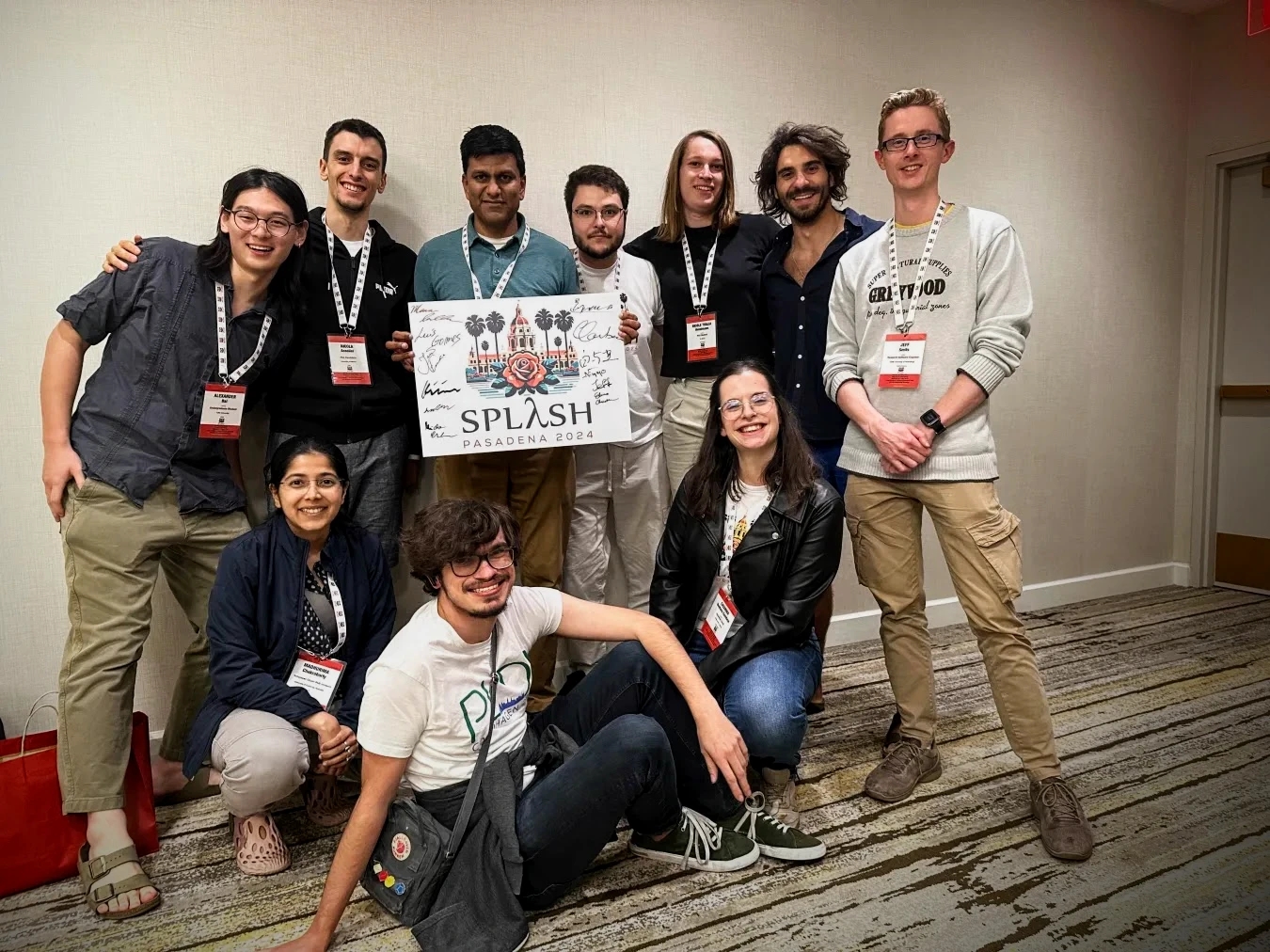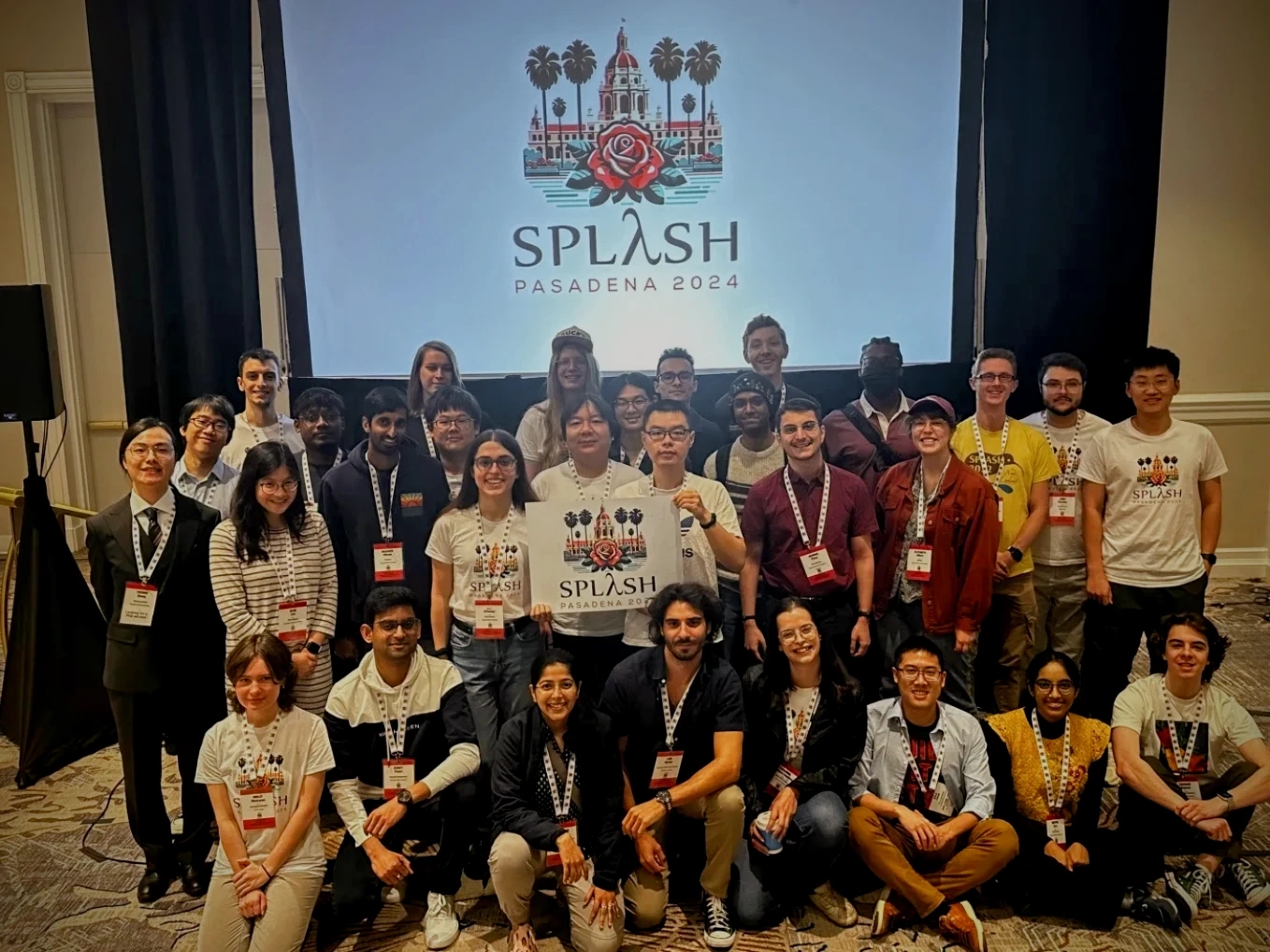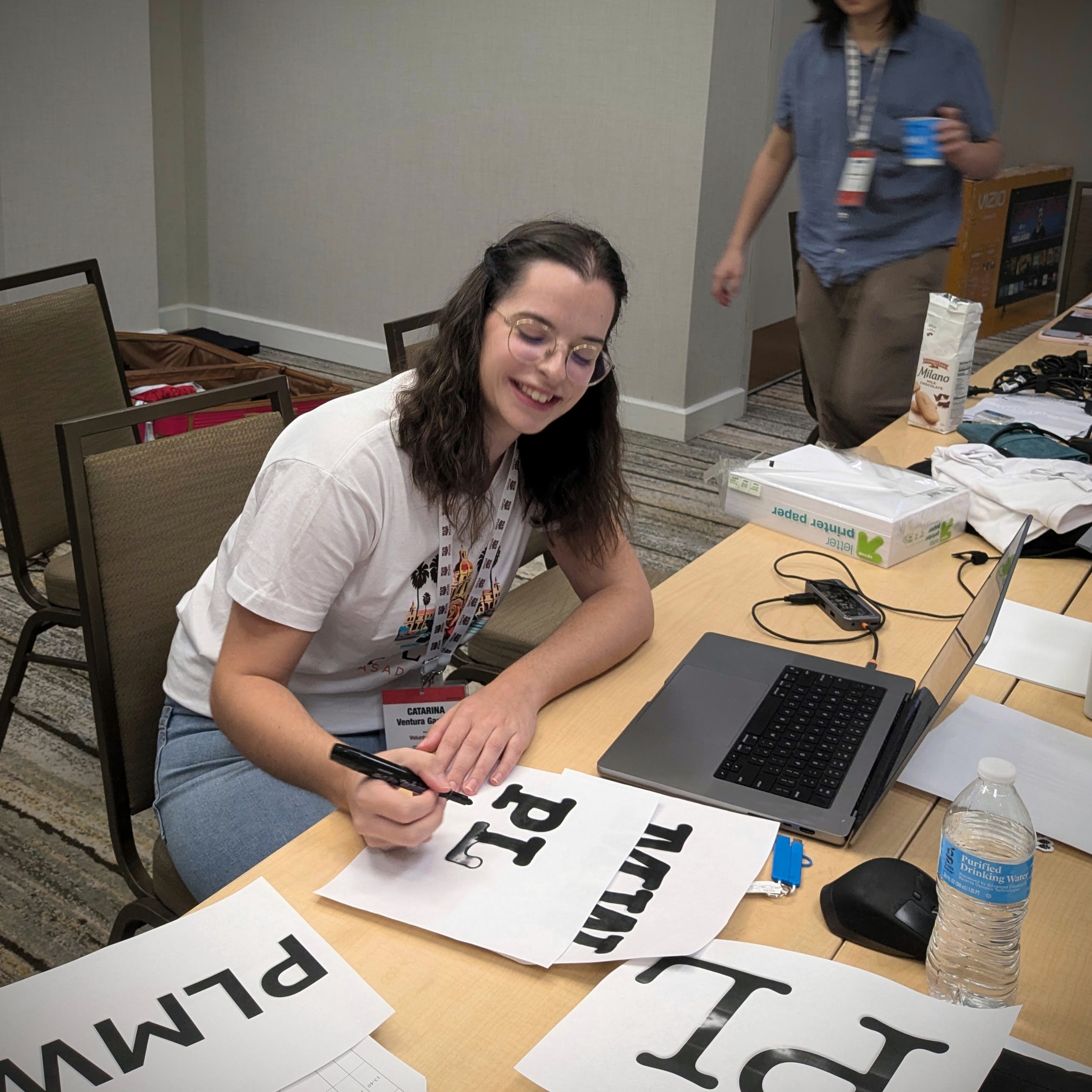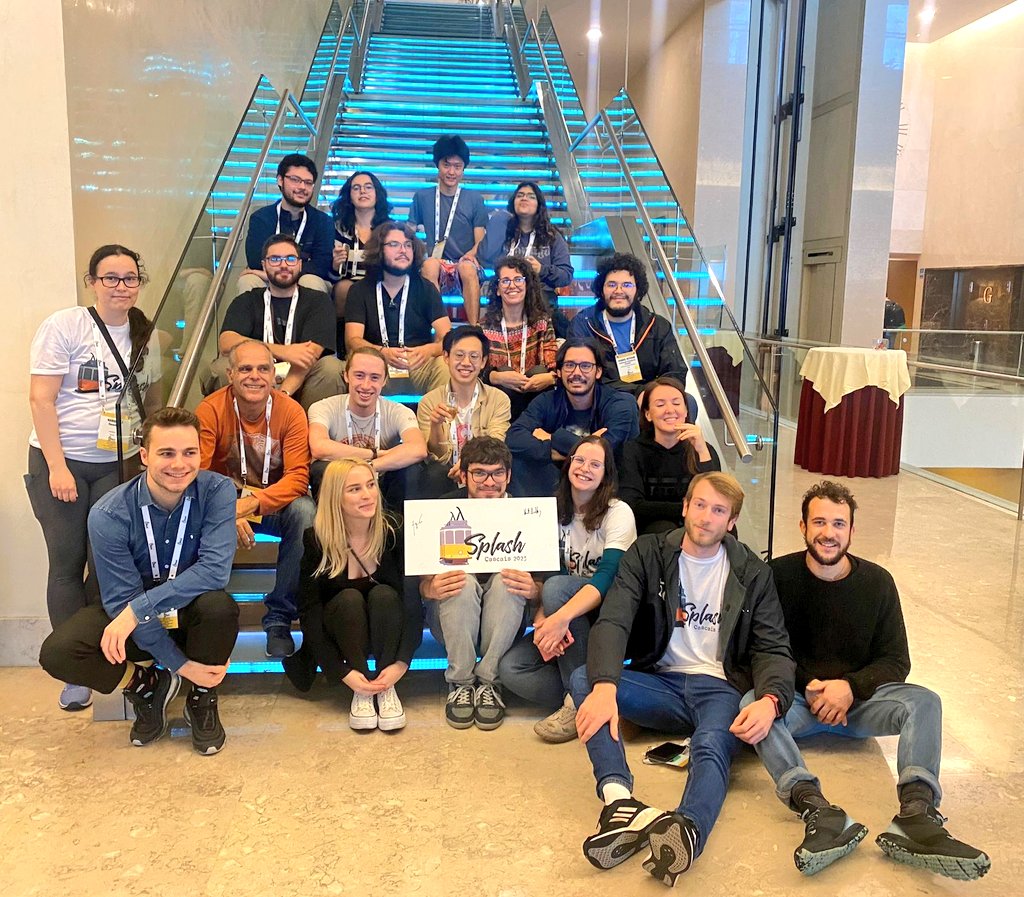Why This Guide?
When I agreed to be Volunteer Chair for SPLASH'23, I felt equal parts excited and terrified. I had volunteered at some conferences before, but coordinating 50+ volunteers? That was a whole different challenge. I reached out to previous chairs (shoutout to Hanneli Tavante!), tried to find information from scattered sources, and learned a lot through trial and error.
After having done it twice—SPLASH'23 in Cascais, and SPLASH'24 in Pasadena, I started writing the guide I wish I'd had at the start and shared it with my team. Now I'm sharing it with everyone!
This isn't just a checklist. It's the practical, honest breakdown of what actually works, what doesn't, and how to handle the inevitable chaos with grace.
If you're about to step into this role, this guide is for you!
What to Expect as a Volunteer Chair
Congratulations on taking on this role! It's challenging but incredibly rewarding. You'll have eyes in every room of the conference, coordinating dozens of volunteers and ensuring everything runs smoothly. The role requires managing schedules, assigning tasks across multiple sessions and locations, ensuring volunteers have the information and resources they need, and doing a lot of on-the-ground troubleshooting as issues arise. You'll also be responsible for maintaining a welcoming, professional atmosphere throughout the event.
Yes, it's a lot of work. Your days will be long! Arriving before sessions start, staying until they end, plus attending social events. But seeing volunteers succeed and have fun, hearing their positive feedback, and knowing you made the conference better makes it all worthwhile. It's also an amazing opportunity to build community, develop leadership skills, and contribute meaningfully to your conference. I have made a lot of friends and professional connections through this role, and I hope you will too!

Volunteer and AV Chairs at SPLASH'24 in Pasadena
Quick reference: Throughout this guide: GC = general chair; OC = organizing committee; CM = conference manager; AV chairs = audio-video chairs
Quick Checklist
Use this as your roadmap. Don't worry if it feels overwhelming, we'll break down each step in the detailed guide below.
Before the Conference
Planning (4 months out)
- Consult with previous volunteer chairs
- Set up applications & confirm timeline with GC/CM
- Populate website & promote applications widely
Selection & Onboarding (3 months out)
- Accept volunteers (plan for ~10% cancellations)
- Arrange t-shirts/identification with GC/CM
- Send registration codes & create Volunteer Guide
- Coordinate volunteer needs with GC/CM
Close to Start (2 weeks out)
- Create schedule (Google Sheets) & attendance tracking system
- Set up communication channel (Discord/Slack)
- Send schedule for volunteers to choose slots
- Build community - encourage introductions
- Plan pre-conference informal meetup (optional)
During the Conference
- Set up Volunteer Hub & hold welcome session
- Organize volunteer dinner (check budget with GC/CM)
- Monitor volunteers daily - rotate between hub & sessions
- Take photos at dinner & arrange group photo
- Think about promising volunteer chairs for next year
After the Conference
- Thank volunteers on communication channel & social media
- Send feedback form to volunteers to complete
- Share attendance data with GC/OC
Detailed Guide
Organization and Team
As a Volunteer Chair, you're not alone! You'll be working closely with your team, the Audio-Video (AV) Chairs, General Chair (GC), Conference Manager (CM), and other members of the Organizing Committee (OC). Building strong relationships with these key players is essential for success.
This structure is specific to SIGPLAN conferences such as POPL, PLDI, SPLASH and ICFP, but other conferences might have similar roles with different names.
The AV Chairs are your closest collaborators. They handle all technical aspects of the conference, including room setups, equipment, and streaming. Regular communication with them ensures that volunteers are well-prepared to assist with AV needs.
For the Volunteer Chairs team, it's ideal to have at least two people: a senior chair with prior experience and a junior chair who can learn the ropes. Ideally, the senior chair already has experience in the role and can mentor the new members. In the follow-up year, the junior will be leading the team!
This mentorship dynamic allows for knowledge transfer and shared responsibilities, making the workload more manageable. As a junior chair, you should learn and ask as many questions as possible, and as a senior chair, you are in charge of the team but let the junior chair take responsibility and lead where possible, especially towards the end of the conference.
💡 Pro Tip: Mentoring inside the volunteer chair team is crucial! Have a senior and junior chair work closely together to ensure knowledge transfer and support.
During the conference, you should also start considering potential volunteer chairs for the next year. Keep an eye out for volunteers who demonstrate leadership, reliability, and enthusiasm. Having a pipeline of future chairs ensures continuity and helps maintain the quality of volunteer coordination in future conferences.
Planning - Tasks Before the Conference
The pre-conference phase is the first part of the heavy lifting. Starting 4 months out might seem early, but trust me, it's not. This timeline gives you breathing room to handle everything without panic.
First things first: Reach out to previous volunteer chairs! They'll save you countless hours by sharing what worked, what flopped, and which pitfalls to avoid. I learned most of what I know from Hanneli's advice before and during SPLASH'23.
Applications
Outreach and building your volunteer team
- Plan the application period according to the acceptance deadlines for research papers and workshops, it is helpful for the applicants to volunteering to already know if they will be presenting or not.
- After deciding on a timeline, confirm with the GC and CM if the timeline is reasonable.
- E.g. at SPLASH'23, we opened a single round of applications and have it open for 1 month, starting 4 months before the beginning of the conference. Other conferences go for 2 rounds of applications depending on the number of applicants and the deadlines.
- Check if you will have virtual volunteers! Virtual volunteers can help check the streams, help virtual attendees, etc.
- Create the application form (Google Forms usually work well). Ask for applicants experience and availability. Check with the AV team for what skills they are looking for on AV volunteers.
- Populate the website with information about the duties and responsibilities (usually the same as past versions of the conference). Be general with the tasks since some specific parts might change between conferences.
- Write clearly what is covered for volunteers (usually registration and access to social events). Even if your website clearly states what's covered (registration, social events), volunteers will still ask. Be patient, it shows they're engaged and want to be sure!
- Once the application is open, share it online to reach as many applicants as possible. Work with the publicity team in the organization. Usually, it is good to share the news over Twitter/X and popular mailing lists and send emails/messages within the organizations of the OC team.
- Contact the GC and CM to see how many volunteers you can have. The number usually depends on the number of paying attendees at the conference.
How many volunteers? 🙋 It depends! You should make an estimate based on the number of sessions and rooms, having 2 volunteers (support and audio-video volunteer) per room/session, plus floaters, and making sure each volunteer has around 12-15 working hours. We had 50 volunteers at SPLASH'23 (6 days, 700+ attendees) and 40 volunteers at SPLASH'24 (6 days, 500+ attendees), with days having up to 11 parallel tracks. Careful with the day of PLMW since many volunteers might want to attend it, and you might not have enough people.
Accepting Volunteers
Building a balanced team and preparing for the inevitable
- Talk with the AV team to help identify the best volunteers to help as AV volunteers.
- Define metrics to accept/decline applicants (usually, it is good to have a mix of senior and junior volunteers, as well as a diversity of backgrounds and experiences).
- Keep in mind that there are cancellations, so make sure that your estimate of volunteers allows for them.
- See if it is possible to have Volunteer t-shirts (or jackets, or others) so that the attendees will quickly identify the volunteers during their shifts. Talk with GC and CM.
- Send acceptance notifications and ask for confirmation (ask for t-shirt sizes in the confirmation form).
- Even after confirmation, people will probably cancel due to last-minute issues.
⚠️ Expect cancellations! Across both SPLASH'23 and SPLASH'24, we consistently saw 10-20% cancellations due to VISA issues, last-minute health problems, travel complications, and changing plans. This depends on the conference location and how many local applicants you have. We had more cancellations for the conference held in Portugal than the one compared in the USA, but there were always some cancellations.
Communication Before the Conference
Setting volunteers up for success
- Send registration codes and steps for registration (use step-by-step instructions)
- Some people might have already registered; ask the GC and CM if they should register again with the Volunteer code and how to handle reimbursements.
- Create the Volunteer Guide as a WIP. It is good to create the Volunteer guide as soon as possible while mentioning that it is a work in progress. Some things will be similar to previous years, but many things might change depending on the venue, GC, AV team, etc.
- Coordinate with the GC and CM on the volunteers' needs besides helping during the talk sessions. For example, ask if they need help with lunches, social events, poster sessions, etc.
- Include the times when volunteers should be ready to work - usually 15mins at the beginning of the shift and 10 mins before each session starts after breaks.
✉️ 1 Task per Email! Having one task per email is the best way to capture attention and ensure clarity. If you have more than one task per email it is very likely that people will miss something important.
Create the Schedule
This is one of the most critical tasks - and one where a good system saves you countless headaches
Wait for the final schedule! Before you dive into creating your volunteer schedule, make absolutely sure the conference schedule is finalized (or will only require very small changes). Talk with the OC to confirm. Building a volunteer schedule on a moving target is a recipe for frustration.
Our setup at SPLASH:
- We had two volunteer types: Support Volunteers (general help) and AV Volunteers (audio-video technical support)
- Used Google Sheets with one sheet per day.
- Included presentation sessions, lunches, floating roles, conference prep (day before), and tear-down (last day)
- AV volunteers also had training sessions built into their schedule, usually at the end of the day before their first shift
- Each conference had multiple locations/rooms to coordinate, requiring careful scheduling to ensure coverage everywhere
💡 Organize schedule according to needs: Usually, workshop days are the busiest! With many parallel tracks running simultaneously, these days need the most coverage. Use color-coding (we used green for all-day workshops) and require volunteers to pick at least one of these high-demand slots first.
Key scheduling strategies:
- Color-code your slots: At SPLASH'23, we used green for all-day workshops, blue for half-day sessions, and orange for floating roles. This made it easy for volunteers to understand their commitments at a glance.
- Always have floaters: These are volunteers on call with no pre-assigned duty. They're your secret weapon for handling last-minute needs and unexpected situations.
- Let volunteers choose: Instead of assigning slots yourself, let volunteers pick their own (within your rules). They'll be happier, more committed, and less likely to request changes. Yes, you might need to do some rearranging afterward, but it's worth it.
Our SPLASH selection rules: Each volunteer chose 1 green slot (all-day workshop), 2 blue slots (half-day sessions or lunch duty), and 1 orange slot (floating). This balanced coverage across busy and quieter times. We refined this approach between '23 and '24, and found that giving volunteers choice within clear structure consistently led to better attendance and fewer last-minute swaps.
⚠️ Set clear deadlines! Give volunteers 1-2 weeks before the conference to choose their slots. Some will wait until the last minute, so send reminder emails as the deadline approaches.
Communication setup: Create a dedicated communication channel (Discord, Slack, or whatever your conference is already using). This will be absolutely essential during the conference when you need to solve problems in real-time.
Community Building
Creating a welcoming team environment before the conference even starts
Your volunteers aren't just workers—they're a team. Building a sense of community before the conference starts pays huge dividends when you need everyone working together smoothly during the event.
Start the conversation early:
- In your communication channel, lead by example: introduce yourself first, share a bit about your background and excitement for the conference
- Encourage volunteers to introduce themselves—where they're from, what they're working on, why they're excited to volunteer
- Make it feel like a safe, welcoming space. The more comfortable volunteers feel asking questions now, the better they'll handle challenges during the conference
🎉 Pre-conference meetup: If you're arriving at the conference site early (or know volunteers who are), organize an informal pre-conference meetup like a casual drink or dinner. It's amazing how much easier it is to work with people you've already met face-to-face!
Check and Setup all documents!
By the start of the conference, you should have the following documents ready:
- Volunteer Guide: A comprehensive document covering roles, responsibilities, logistics, and FAQs.
- Volunteer Schedule: A clear, color-coded schedule showing who is assigned to what and when.
- Attendance Tracking System: A simple spreadsheet with all sessions present to log attendance numbers during the conference. - The attendance numbers should be updated by the volunteers and sent to the GC at the end of the conference.
During the Conference
This is it—game time! All your preparation is about to pay off. Your days will be long (arrive early, leave late, attend social events), but seeing everything come together makes it worthwhile.
Remember: You're not just managing logistics—you're supporting people. Check in with volunteers regularly, be visible and approachable, and create an atmosphere where people feel comfortable asking for help.

Our amazing volunteer team at SPLASH'24
Welcome Session
Lesson learned and applied: We didn't do a formal welcome session at SPLASH'23, and I regretted it. For SPLASH'24, we added a brief 15-minute welcome gathering and debrief every morning. The difference was noticeable—volunteers felt more connected to each other and to us as chairs from the start.
Keep it short and welcoming: introduce yourself and co-chairs, thank everyone for volunteering, go over key logistics (where the volunteer hub is, how to use the communication channel, who to contact for what, what to do in each session), and give people a chance to put faces to names. Think of it as a quick team huddle, not a formal meeting.
Daily wrap ups
Early feedback: Besides the morning debriefs, it's also helpful to have a quick wrap-up at the end of each day. This can be a brief 10-15 minute session where you gather feedback from volunteers about how the day went, any challenges they faced, and suggestions for improvement. It also serves as a moment to acknowledge their hard work and celebrate successes. We didn't do this at SPLASH'23/24 but Luis Gomes did it for '25 and it was a great addition (thanks for the suggestion!).
💡 Debriefs: Morning debriefs allow for people to get to know each other and recognize the chairs! It also allows you to ensure that everyone knows their role and feels supported. End-of-day wrap-ups allow you to get feedback and change anything relevant before the next day.
Volunteer Dinner
This is one of the highlights! A volunteer dinner is a wonderful way to thank your team and build camaraderie. You might not know if there's budget until the conference starts, so check with the GC and CM before the conference and early in the week.
Scheduling the dinner:
- Avoid nights with major conference events (reception, conference banquet, affinity group dinners)
- Don't schedule it for the last night—many volunteers leave early
- Mid-conference works best, giving people time to bond while everyone's still around
📸 Don't forget photos! Take lots of pictures during the dinner. These are great for thanking volunteers on social media afterward. If possible, arrange a volunteer group photo—though timing this can be tricky with everyone's schedules.
The Volunteer Hub
Set up a Volunteer Hub—typically at or near the registration desk. This should be the go-to place where volunteers know they can always find a chair or get help.
Daily operations strategy:
- Divide and conquer: One chair stays at the hub as the "home base" while the other circulates between sessions, checking that volunteers are in place and everything's running smoothly
- Watch your communication channel like a hawk: This is where "fires" will pop up. Respond quickly and encourage volunteers to share problems—no question is too small
- Be visible and approachable: Walk around, check in with volunteers, and make sure they know you're there to support them

Part of the job: handling unexpected situations and keeping things running smoothly (SPLASH'24)
Be ready for the unexpected: Some of the most memorable moments come from handling situations you never planned for. Maybe the rooms were reassigned, and you need to re-route participants, maybe poster boards are needed last minute, or maybe a volunteer doesn't show up, and you need to fill in. Your ability to stay calm, think on your feet, and coordinate with your team will be tested—and this is where all your preparation pays off. This is also where having floaters is invaluable; they can step in wherever needed.
Real talk about the schedule: Your days will be long—arrive before the conference starts, stay until after it ends, plus attend social events. This is exhausting but rewarding. Prioritize sleep before, during, and after the conference. You can't support your team if you're running on empty. Rely also on your co-chairs for support. Share the load, debrief together at the end of each day, and celebrate small wins.
📢 Words of encouragement At the end of every day, take a moment to acknowledge the hard work of your volunteers. A simple "thank you" can go a long way in boosting morale.
Next year's team!
It might seem early to think about next year, but during the conference is the perfect time to identify potential volunteer chairs for the following year. In my first year as chair, I didn't think about this until the conference was over, and so I wasn't really focused on identifying people that could join the team next year as chairs, which was a missed opportunity. During the conference, keep an eye out for volunteers who demonstrate leadership, reliability, and enthusiasm. After the conference, reach out to them to gauge their interest in taking on a chair role next year. That being said, in some cases, the GC already has someone in mind for next year, so check with them before reaching out to potential candidates.
After the Conference
You made it! The conference is over, but your job isn't quite done yet. Take a moment to celebrate what you accomplished—coordinating dozens of people across multiple days is no small feat.
Showing Appreciation
Thank your team publicly and genuinely:
- Post a heartfelt thank you on the communication channel while everyone's still connected
- Share appreciation on the conference's social media (those dinner photos come in handy!)
- Tag volunteers if appropriate—public recognition means a lot
Gathering Feedback
Send a feedback form to all volunteers. Keep it short and focused. Ask what worked well, what could be improved, and what surprised them. This feedback is gold for future volunteer chairs (and for your own reflection).
💡 Make it easy: Use a simple Google Form with a mix of rating scales and open-ended questions. The easier it is to complete, the more responses you'll get.
Administrative Wrap-up
- Compile and send the session attendance numbers to the GC/OC
- Document anything you wish you'd known at the start—future volunteer chairs will thank you
- Archive important documents (schedules, guides, etc.) somewhere the organizers can access them next year
Most important - Advocate for Volunteers
Your role is not only to ensure that the conference runs smoothly, but also to be the voice for your volunteers. Ensure that they rest and are not overworked, and have time to eat and drink. For all of this you need to coordinate schedules with the organization and have enough volunteers. Additionally, the volunteers should to be integrated in the conference and NOT be segregated from other participants. For example, in the past it was suggested that volunteers have separate lunches due to space constraints, but you should fight these ideas since volunteers are here to be in the conference and enjoy it as much as anyone else especially when they don't have shifts. Sometimes the organization might suggest changes or ideas that could negatively impact the volunteers, and it is your job to speak up for them and ensure that their well-being is prioritized.🥊 Fight for your volunteers You are responsible for them and need to shield them from any issues that arise! You need to make sure that their needs are being met and that they are treated with respect and appreciation, and if that means pushing back against the organization, do it!
Final Thoughts
Being a Volunteer Chair is one of those roles where you're constantly juggling logistics, people management, and unexpected problems. It's challenging, sometimes stressful, but ultimately incredibly rewarding.
Having done this role before and volunteered at many other conferences, I've learned that the key to success isn't perfection—it's preparation, flexibility, and genuine care for your volunteer team. Things will go wrong. Volunteers will cancel last minute. You'll forget something. Technology will fail at the worst possible moment. And that's okay. What matters is how you respond and support your team through it all.
One of my favorite parts of this role is building community and creating connections that last beyond the conference.
It is great to see first-time volunteers who start nervous, ending up the conference confidently helping others, and making many friends and connections.
For myself, I have made so many friends and collaborators that what I most look forward in conferences is to seeing them again!
It is also amazing to get to know the behind the scenes of our conferences, help it grow, and have an active voice from a perspective that is often overlooked!
I couldn't have done any of this without the help of my co-chairs -- Hanneli, Luis, Madhurima --, the amazing AV team, and the great volunteers that trusted us to lead them.
After doing this for two years and seeing volunteers at 8+ other conferences, I can say with certainty: a well-supported volunteer team doesn't just help run the conference, they enhance the entire experience for everyone.
My biggest takeaways:
- Start early and over-communicate
- Build community, not just a work schedule
- Be visible, approachable, and responsive during the conference
- Plan for things to go wrong (they will!)
- Celebrate the wins, both big and small
If you're about to take on this role: You've got this! Yes, it's a lot of work, but you're contributing to something bigger—creating an amazing experience for hundreds of attendees and giving volunteers meaningful opportunities to engage with their community.
And when it's all over and a volunteer comes up to you saying they had an amazing time? That makes every early morning and late night worth it.
Good luck, and feel free to reach out if you have questions or suggestions!
— Catarina
